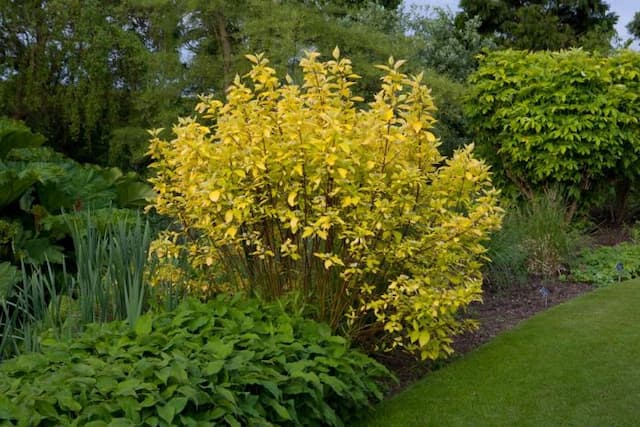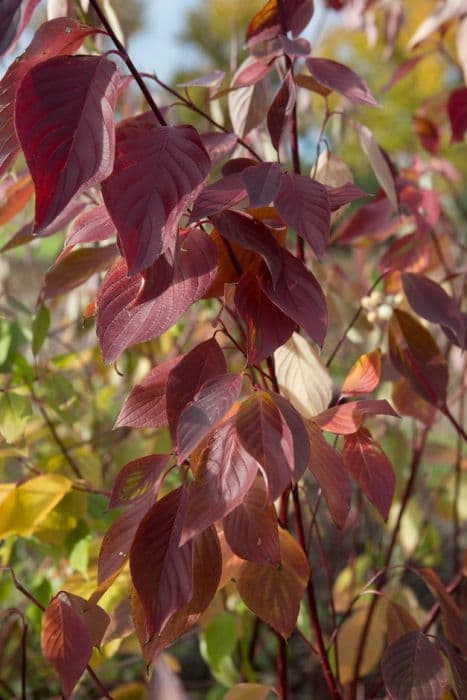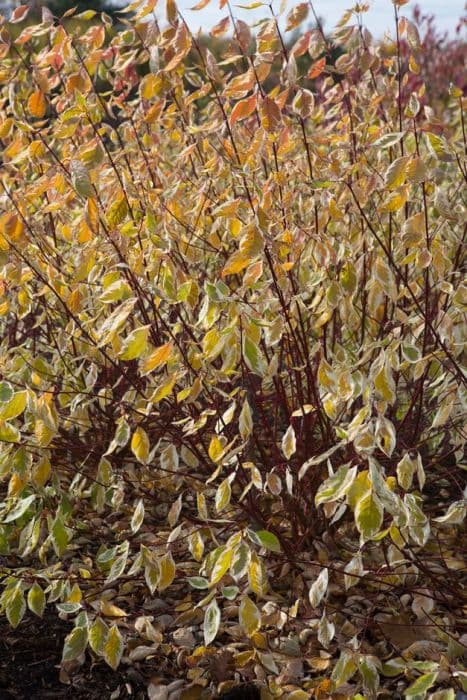Bloodtwig dogwood Cornus sanguinea 'Anny's Winter Orange'











ABOUT
The plant known as 'Anny's Winter Orange' is a visually striking variety with several distinctive features that create interest throughout the seasons. In spring and summer, its foliage is lush and green, offering a backdrop for the flat clusters of white flowers that emerge, attracting pollinators to the garden. As autumn approaches, the leaves transform into a fiery display of oranges and reds, a vibrant autumnal palette that remains until the foliage drops. Winter unveils one of the plant's most spectacular aspects with its stems that glow in a vibrant, orange tone, standing out against the bleakness of the winter garden. These stems provide a stark contrast to the often gray and white wintery landscape. While it may bear small blue-black berries, the most remarkable characteristic of this cultivar is undoubtedly its winter stem color, which makes it a favorite among gardeners looking for year-round interest.
About this plant
 Names
NamesFamily
Cornaceae
Synonyms
Bloodtwig Dogwood, Common Dogwood, European Dogwood, Midwinter Fire
Common names
Cornus sanguinea 'Anny's Winter Orange'.
 Toxicity
ToxicityTo humans
Bloodtwig dogwood is generally considered to be non-toxic to humans. However, as with many plants, individual sensitivity can vary, and it is always a good idea to avoid ingesting parts of ornamental plants as a precaution. If there were any toxicity, it would likely be mild and could potentially include stomach upset or a reaction in particularly sensitive individuals.
To pets
Bloodtwig dogwood is also not known to be particularly toxic to pets, including dogs and cats. While the ingestion of large amounts of plant material could lead to gastrointestinal discomfort or more serious issues simply due to the foreign matter in the stomach, this plant is not commonly associated with serious poisoning in pets. However, pet owners should discourage their animals from eating non-food plants, as they can still cause vomiting or diarrhea even if they aren't toxic.
 Characteristics
CharacteristicsLife cycle
Perennials
Foliage type
Deciduous
Color of leaves
Green
Flower color
White
Height
6 6 [2 2]
Spread
5 0 [1 5]
Plant type
Shrub
Hardiness zones
5
Native area
Europe
Benefits
 General Benefits
General Benefits- Year-round interest: This plant is known for its seasonal changes, offering vibrant orange-red stems in winter, lush green foliage in spring and summer, followed by autumn colors.
- Wildlife attraction: It provides a habitat and food source for birds and beneficial insects, especially when it bears fruit.
- Low maintenance: Being a hardy plant, it generally requires minimal care once established, making it suitable for various landscape situations.
- Erosion control: Its dense root system helps stabilize soil and control erosion, particularly on slopes or banks.
- Privacy screening: It can be used as a hedge or screen to add privacy to gardens due to its dense growth habit.
- Architectural structure: Its distinctive stem color in winter provides a strong architectural element to otherwise barren landscapes.
- Adaptability: It adapts well to a variety of soil types and conditions, although it prefers moist, well-drained soil.
 Medical Properties
Medical PropertiesThis plant is not used for medical purposes.
 Air-purifying Qualities
Air-purifying QualitiesThis plant is not specifically known for air purifying qualities.
 Other Uses
Other Uses- Crafts: The vibrant stems of 'Anny's Winter Orange' can be harvested and used in wreath-making or floral arrangements for a pop of natural color during the winter months.
- Photography: The stark contrast between the plant's orange-red stems and snowy landscapes provides a stunning subject for winter photography enthusiasts.
- Natural Dyes: The bark or berries of the plant can be used to create natural dyes for fabric, though the color fastness and intensity may vary.
- Ink Making: Similar to natural dyes, the tannins in the bark could potentially be used for crafting homemade inks for art or calligraphy.
- Support Structures: The straight stems of the Dogwood can be employed as support stakes for other plants in the garden during the growing season.
- Garden Art: The branches can be arranged in artistic forms or patterns within the garden to provide year-round interest, especially when other plants are dormant.
- Educational Use: This Dogwood variety can be used in botanical studies to teach about plant adaptation, as it features vivid winter stem coloration as a survival strategy.
- Wildlife Shelter: The thickets formed by 'Anny's Winter Orange' can provide important winter shelter and habitat for birds and small mammals.
- Winter Garden Design: This variety can be strategically planted to enhance the aesthetics of a winter garden, providing a burst of warm color against a monochrome landscape.
- Erosion Control: The root systems of Dogwood shrubs, including 'Anny's Winter Orange', can help stabilize soil and prevent erosion on slopes or banks.
Interesting Facts
 Feng Shui
Feng ShuiThe Bloodtwig Dogwood is not used in Feng Shui practice.
 Zodiac Sign Compitability
Zodiac Sign CompitabilityThe Bloodtwig Dogwood is not used in astrology practice.
 Plant Symbolism
Plant Symbolism- Resilience: The Cornus sanguinea 'Anny's Winter Orange', commonly known as the Bloodtwig Dogwood, often symbolizes resilience due to its hardiness and ability to withstand cold winter temperatures.
- Protection: In some traditions, the Bloodtwig Dogwood is seen as a protector because of its thick, sturdy branches that can serve as a physical barrier.
- Renewal: This plant is known for its vibrant winter color, which can signify the idea of renewal and the promise of spring after the dormancy of winter.
- Strength: The Bloodtwig Dogwood's robust growth and strong wood have made it a symbol of strength and stability.
- Purity: Dogwoods, in general, have been associated with purity, which can be attributed to the clean and crisp appearance of their bark and stems, especially pronounced in the winter landscape.
 Water
WaterBloodtwig dogwood should be watered consistently, especially during its first growing season to establish a deep, extensive root system. Once established, they're relatively drought tolerant but prefer regular watering. Aim to provide about 1 inch of water weekly, either from rainfall or supplemental watering. During hot or dry periods, you might need to water two times a week. Be mindful to avoid overwatering and ensure the soil is well-draining to prevent root rot.
 Light
LightBloodtwig dogwood thrives in full sun to partial shade. The ideal spot would offer morning sunlight and afternoon shade, especially in hotter climates, to protect the plant from harsh afternoon sun. Adequate light is vital for the plant to develop its vibrant winter stem coloration.
 Temperature
TemperatureBloodtwig dogwood is hardy and adapts well to a range of temperatures. It can survive minimum winter temperatures down to -30 degrees Fahrenheit and is comfortable in summer temperatures up to 95 degrees Fahrenheit. The ideal growing temperatures range between 60 and 75 degrees Fahrenheit for optimal foliage and stem color development.
 Pruning
PruningBloodtwig dogwood benefits from pruning to encourage vibrant stem color in winter and maintain an attractive shape. Prune in late winter or early spring before the new growth starts, removing about a third of the oldest stems at ground level each year. This rejuvenates the plant and stimulates the growth of new stems that have the best color.
 Cleaning
CleaningAs needed
 Soil
SoilBloodtwig dogwood 'Anny's Winter Orange' prefers well-draining soil with high organic content. A good mix can be created using equal parts of garden soil, compost, and peat moss or leaf mold. Aim for a soil pH of 5.5 to 7.5 for optimal growth.
 Repotting
RepottingBloodtwig dogwood 'Anny's Winter Orange' is a garden shrub and typically does not require repotting as it is planted directly in the ground.
 Humidity & Misting
Humidity & MistingBloodtwig dogwood 'Anny's Winter Orange' is tolerant of a range of humidity levels and does well in the natural outdoor humidity common in its growing zones.
 Suitable locations
Suitable locationsIndoor
Not ideal for indoors; needs outdoor space to grow.
Outdoor
Plant in sun or partial shade, water regularly, well-draining fertile soil.
Hardiness zone
4-7 USDA
 Life cycle
Life cycleCornus sanguinea 'Anny's Winter Orange', commonly known as the Bloodtwig Dogwood 'Anny's Winter Orange', starts its life cycle as a seed, which upon germination in early spring grows into a seedling with characteristic green foliage. As it matures into a young plant, it develops a strong root system and multiple stems, later forming a bushy habit. Throughout the spring and summer, the Bloodtwig Dogwood produces leaves and by late spring, it blossoms with small white flowers, which are often followed by the development of small, spherical blue-black fruit. In autumn, the leaves of 'Anny's Winter Orange' turn a fiery orange-red before falling off, and the stems of the plant take on a bright orange hue, which provides winter interest. During the winter, the plant enters a period of dormancy, conserving energy and resources. With the return of favorable growing conditions in the following spring, the cycle recommences as the plant resumes growth, starting with new leaf production.
 Propogation
PropogationPropogation time
Early Spring
Cornus sanguinea 'Anny's Winter Orange', commonly known as Bloodtwig Dogwood, is typically propagated by hardwood cuttings. The most appropriate time for this method is during the plant's dormant period in late fall to late winter. Cuttings should be taken from healthy, mature stems that have grown in the previous season. These stems are cut into segments about 6 to 9 inches (15 to 23 centimeters) long, and the lower end of each cutting is dipped in rooting hormone to encourage root development. The cuttings are then planted in a well-draining propagation medium and kept moist until roots have developed and new growth is evident, indicating that the cutting has been successfully propagated.

![Dogwood [Baton Rouge]](/_next/image?url=https%3A%2F%2Fplants-admin.emdemapps.com%2Fimages%2Fplants%2F%2Fimages%2F604b59cf0fefd.png&w=640&q=75)


![Dogwood [Ivory Halo]](/_next/image?url=https%3A%2F%2Fplants-admin.emdemapps.com%2Fimages%2Fplants%2F%2Fimages%2F604b535cbcb9a.png&w=640&q=75)




